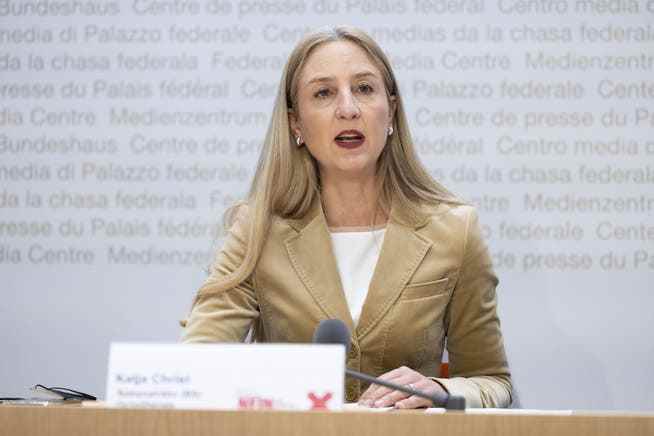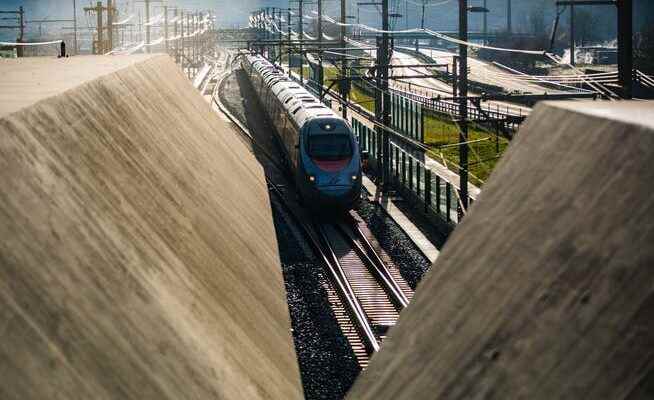The federal government wants to strengthen local transport by 2050. However, high-speed trains are not an issue. That is why the GLP national councilor Katja Christ submits a postulate. She is demanding a roadmap and a more global vision from the Federal Council.
The Gotthard Base Tunnel was a grand vision. Now, however, such are missing for the future, says GLP National Councilor Katja Christ.
When Katja Christ talks about this topic, she picks up speed – just like a high-speed train. You can hear the dissatisfaction in her voice, as well as the impatience. At some point, the Basel National Councilor of the Green Liberals said in an interview: “I find the federal government’s plans for the next thirty years lacking in vision and discouragement. Point!”
The federal government recently presented its “Perspective Bahn 2050”. He wants to use it to expand local transport and medium-distance routes. There is no mention of high-speed lines. They are explicitly excluded. While Europe is planning in this regard, Switzerland is not “on board”, says Christ. “Europe’s fast trains will bypass us.”
Below 100 km/h on average
The Swiss public transport network is branched out into the most remote valleys, dense, more developed than almost anywhere else. But our trains travel at a leisurely pace over long distances. “SBB – the slowest railway in Europe”, wrote the CH-Media newspapers last spring. On many important lines, such as between Zurich and St. Gallen or between Bern and Lausanne, the average speed is less than 100 km/h.
With the European neighbors Germany, France and Italy routes with 300 km/h are widespread. They have largely pushed the airplanes out of the market. Swiss, on the other hand, still flies five to six times a day from Zurich to Geneva. In Switzerland there are still only four short railway sections that are suitable for 200 km/h. “But internationally, high speeds are above 250 km/h,” says Christ, “so we don’t have the connection to the foreign high-speed network.” For example, the Italian Frecciarossa could dash from Milan to Bern, Basel or Zurich.
Where is the potential for saving time?
The federal government is not planning to do this until 2050. That’s why Christ reacted on Wednesday: She submitted a postulate to Parliament calling for a roadmap for high-speed corridors in Switzerland as well. Now the Federal Council must comment on where it sees potential for time savings and CO2-Savings thanks to high-speed routes and how Switzerland can participate in the expansion of the continental high-speed network. So far it is not part of the study “Smart and affordable High-Speed Services in the European Union”.

GLP National Councilor Katja Christ wants a bolder railway strategy.
Instead of speed, the federal government relies on density. The Federal Office of Transport (FOT) sees potential in western and eastern Switzerland, says Andreas Windlinger, Head of Communications at the BAV. There they want to expand, speed up and invest in routes. “But not on a high-speed network.”
By 2025, additional S-Bahn services are to be created in the agglomeration and suburban train stations are to be served with more interregio and regional express trains. In its studies, the BAV recognizes the greatest potential on these routes, so it wants to lure passengers from private to public transport. In the agglomerations, most journeys are made per day.
Long-distance travel as the greatest environmental impact
Christ is skeptical about these calculations. From their point of view, not the distances, but the kilometers per day should serve as a basis. With regard to climate protection, it is not decisive whether you drive twenty times by car from Riehen to Basel instead of taking the S-Bahn, but whether you take the train from Basel to Barcelona or the plane, says Christ.
In the postulate, she lists EU data according to which a quarter to a third of the CO2-Emissions are caused by long-distance travel. An SBB study also comes to the conclusion that the greatest leverage would be “travel time reductions, more frequent services and direct connections”.
Good public transport in the agglomerations may have an effect. But if the train is not attractive enough for the longer distances, there will continue to be massive emissions. “We can’t just look at the potential for a shift towards rail within Switzerland. Where’s the international vision in that?” Christ asks himself. The NEAT was one of those, now more are needed.
Urban sprawl and too much concrete
The federal government also has the climate goals in mind, as Windlinger from the BAV says. But he pursues her in a different way. “Shorter travel times would mean that urban sprawl would increase and people would work further away from where they live,” says Windlinger. The federal government does not want to create any incentives for long-term commuters. Because that also pollutes the environment.
In addition, many tunnels and therefore a lot of concrete are required for the construction of high-speed routes – this also leads to a high level of environmental pollution. And finally, high-speed trains would consume a disproportionate amount of electricity. “That’s not what we want at the moment either,” says Windlinger.
These are reasons that Christ does not want to accept. These arguments do not include who uses cars or planes instead of trains for longer distances. “Energy consumption must be looked at in the EU context,” says Christ. In the long term, the train is not competitive on the Basel-Milan route. You don’t necessarily have to be slower by car. But if you can get from Basel to Milan on the rails in three hours, then the train becomes much more attractive as a means of transport. “We must also have an answer for these routes.” So far, the Federal Council has not found this to be the case. Whether the postulate will make him change his mind is questionable.
